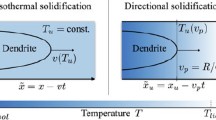Abstract
Computer simulation techniques were used to explicate solid solution strengthening in fcc metals. With this approach, it was not necessary to make a number of the assumptions used in analytical investigations. A semicontinuum model, with a flexible dislocation line interacting with a random array of solute atoms, was employed. The dislocation line tension was assumed constant, and classical elastic size or modulus interactions were assumed between the solute atoms and the dislocation line segment. The size effect was again found to be dominant, and the yield stress was predicted as {\(\tau _y \)}=0.069 με4/3 1/2. Although there were no adjustable parameters in this study, agreement with experimental data was quite good.
Similar content being viewed by others
References
H. Suzuki:Dislocations and Mechanical Properties of Crystals, John Wiley, New York, NY, 1957, p. 361.
M.Z. Butt and P. Feltham:Acta Metall., 1978, vol. 26, p. 167.
N.F. Mott and F.R.N. Nabarro: Report of a Conference on the Strength of Solids, University of Bristol, England, Physical Society, London, 1948.
R.L. Fleischer:Acta Metall., 1962, vol. 10, p. 835.
R.L. Fleischer:Acta Metall., 1963, vol. 11, p. 203.
R.L. Fleischer:The Strengthening of Metals, Reinhold Publishing Co., New York, NY, 1964, p. 93.
J. Friedel:Dislocations, Addison-Wesley Publishing Co., Reading, MA, 1964.
R. Labusch:Phys. Stat. Sol., 1970, vol. 41, p. 659;Acta Metall., 1972, vol. 20, p. 917.
R. Labusch:Rate Processes in Plastic Deformation of Materials, Proc. J.E. Dorn Symp., Plenum Press, New York, NY, 1975, p. 26.
T. Suzuki:Dislocation Dynamics, McGraw-Hill, New York, NY, 1968, p. 551.
O. Boser:Metall. Trans., 1972, vol. 3, pp. 843–49.
O. Boser:J. Appl. Phys., 1973, vol. 44, pp. 1033 and 1038.
B.R. Riddhagni and R.M. Asimow:J. Appl. Phys., 1968, vol. 39, pp. 4144, and 6159.
U.F. Kocks:Metall. Trans. A, 1985, vol. 16A, pp. 2109–29.
W.R. Tyson:Physics of Solid Solution Strengthening, Plenum Press, New York, NY, 1973, p. 47.
A.H. Cottrell, S.C. Hunter, and F.R.N. Nabarro:Phil. Mag., 1953, vol. 44, p. 1064.
F.R.N. Nabarro:J. Less-Common Metals, 1972, vol. 28, p. 257.
F.R.N. Nabarro:Phil. Mag., 1977, vol. 35, p. 613.
F.R.N. Nabarro:Dislocation and Properties of Real Materials, The Institute of Metals, London, 1985, p. 152.
R.J. Arsenault, R. Hsu, and D. Esterling:Scripta Metall., 1981, vol. 15, p. 567.
R.J. Arsenault, S. Patu, and D.M. Esterling:Metall. Trans. A, 1989, vol. 20A, pp. 1411–18.
A.J.E. Foreman and M.J. Makin:Phil. Mag., 1966, vol. 14, p. 911.
A.J.E. Foreman and M.J. Makin:Can. J. Phys., 1967, vol. 45, p. 511.
Proc. 1976 Int. Conf. on Computer Simulation for Materials Applications, R.J. Arsenault, J.R. Beeler, Jr., and J.A. Simmons. eds., NBS, Gaithersburg, MD, April 1976; R. Labusch and R.B. Schwartz, vol. 2, p. 650; S.I. Zaitsev and E.M. Nadgornyi, vol. 2, p. 707; R.O. Scattergood and E.S.P. Das, vol. 2, p. 740; K. Hanson, S. Altintas, and J.W. Morris, Jr., vol. 2, p. 917.
R.J. Arsenault and T.W. Cadman:Phil. Mag., 1970, vol. 24. p. 259;Scripta Metall., 1972, vol. 6, p. 593;Scripta Metall., 1973, vol. 7, p. 631;Phys. Stat. Sol., 1974, vol. 24, p. 299;Rate Processes in Plastic Deformation, ASM, 1975, vol. 4, p. 102;Scripta Metall., 1978, vol. 12, p. 633;Metall. Trans. A, 1980, vol. 11A, pp. 127–34.
K. Ono: Proc. 3rd Int. Conf. on the Strength of Metals and Alloys, Cambridge, England, The Institute of Metals and The Iron and Steel Institute, 1973, p. 6.
C.T.K. Kuo and R.J. Arsenault:Mater. Sci. Eng., 1976, vol. 27, p. 11; 1977, vol. 30, p. 65.
J. Weertman and J.R. Weertman:Elementary Dislocation Theory, 3rd ed., Macmillan Co., New York, NY, 1967, p. 173.
J.P. Hirth and J. Lothe.Theory of Dislocations, McGraw-Hill, New York, NY, 1968, p. 624.
M. Cominou and J. Dundurs:J. Appl. Phys., 1972, vol. 43, p. 2461.
M. Cominou: M.S. Thesis, Northwestern University, Evanston, IL, Aug. 1971.
P. Haasen:Physical Metallurgy, Cambridge University, Cambridge, England, 1978.
D.J. Bacon, U.F. Kocks, and R.O. Scattergood:Phil. Mag., 1973, vol. 28, p. 1241.
D.M. Esterling and R.J. Arsenault:Metall. Trans. A, 1982, vol. 13A, pp. 1429–34.
H. Suzuki:Strength of Metals and Alloys, Pergamon Press, New York, NY, 1985, vol. 3, p. 1727.
W.E. Nixon and J.W. Mitchell:Proc. Royal Soc. London, 1981, vol. 376A, p. 343.
Z.S. Basinski, R.A. Foxall, and R. Pascual:Scripta Metall., 1972, vol. 6, p. 807.
Author information
Authors and Affiliations
Rights and permissions
About this article
Cite this article
Arsenault, R.J., Patu, S. & Esterling, D.M. Computer simulation of solid solution strengthening in Fcc alloys: Part II. At absolute zero temperature. Metall Trans A 20, 1419–1428 (1989). https://doi.org/10.1007/BF02665499
Received:
Issue Date:
DOI: https://doi.org/10.1007/BF02665499




